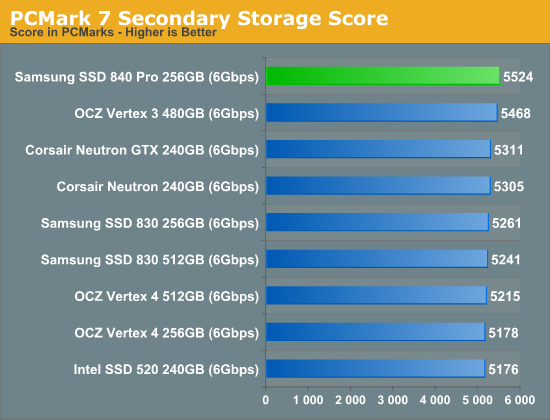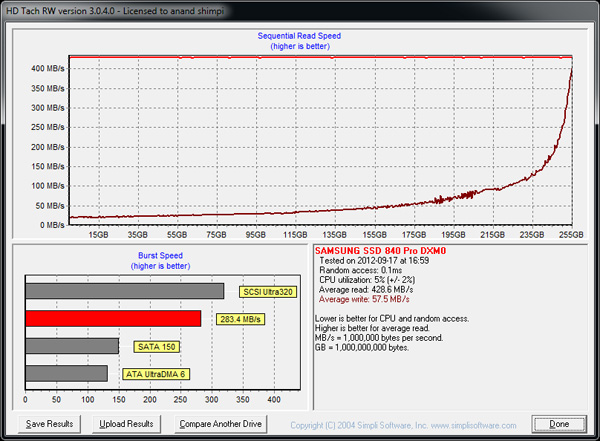Samsung SSD 840 Pro (256GB) Review
by Anand Lal Shimpi on September 24, 2012 7:00 AM EST- Posted in
- Storage
- SSDs
- Samsung
- Samsung SSD 840
PCMark 7
PCMark 7's secondary storage benchmark does little to show us differences between modern, high-performance SSDs as everything here scores within 5% of one another - but that's the point. For most mainstream client uses you'd be hard pressed to tell the difference between two good 6Gbps SSDs. Worry more about cost and reliability than outright performance if you're considering an SSD for a normal machine. Anything you see here will be much faster than a mechanical drive.

Performance Over Time & TRIM
Over time SSDs can get into a fairly fragmented state, with pages distributed randomly all over the LBA range. TRIM and the naturally sequential nature of much client IO can help clean this up by forcing blocks to be recycled and as a result become less fragmented. Leaving as much free space as possible on your drive helps keep performance high (20% is a good number to shoot for), but it's always good to see how bad things can get before the GC/TRIM routines have a chance to operate. As always I filled all user addressible LBAs with data, wrote enough random data to the drive to fill the spare area and then some, then ran a single HD Tach pass to visualize how slow things got:
The 840 Pro is really no different than the 830 when it comes to how low performance can get in the worst case scenario. Client users will want to keep some free space on the drive to avoid getting backed into this type of a performance corner. TRIM will obviously help and looks to be fully functional on the 840 Pro:












96 Comments
View All Comments
stoked - Monday, September 24, 2012 - link
Do these drives include power loss protection like the Intel 320's?Kristian Vättö - Monday, September 24, 2012 - link
Simply and shortly, no. However, Samsung showed a few enterprise SSDs as well, which may have (they were simply on display, so I'm not sure).lunadesign - Monday, September 24, 2012 - link
Anand - How does this drive do in cases where TRIM isn't an option? How does it compare to the M5 Pro in this area?kpo6969 - Monday, September 24, 2012 - link
Anand- If you only had a choice of two drives to put in your own system would you go with this one or the Plextor M5 Pro? Just wondering, thanks.Zoomer - Monday, September 24, 2012 - link
However, the new Sandforce controller isn't out yet. We'll see.Magichands8 - Monday, September 24, 2012 - link
Technically this all looks great. Nice performance and power characteristics across the board. But where is the real distinguishing factor? All these drives are getting capped out thanks to SATA limitations and how much am I going to notice the difference between 500 MB/s and 490 MB/s in real world usage? Prices remain high and capacities remain low. We have reliability, high performance, low power usage and even TRIM over RAID now. SAMSUNG, INTEL, MICRON, OCZ, SANDISK, are you listening?! We need higher CAPACITIES, NOT irrelevant PERFORMANCE gains from intermittent firmware tweaks every six months!I read somewhere that it's going to take another year/year-and-a-half for them to build/expand/retool plants to the point where we can see reasonable capacity increases at reasonable prices but it's very frustrating and disappointing to see basically no improvement upon capacities with extremely sluggish price improvement. It's getting to the point where I'm not even interested in new SSD reviews anymore.
However if capacities ever hit 2TB+ for $250-$300 I have a hard time imagining what could compel me to buy traditional HDDs when my main concerns with such an array would boil down to a mechanical failure somewhere, heat, noise and space (which are all addressed by SSDs). I'm sure that the new tech coming down the pipes for magnetic storage are going to do wonders for capacities but at some point that almost becomes a liability since there will always be a huge performance bottleneck.
seapeople - Monday, September 24, 2012 - link
Considering that I paid ~$2/GB for an Intel SSD just 18 months ago, and now drives that are twice as fast are selling for half as much, I'd say you're being unreasonably impatient.Grok42 - Monday, September 24, 2012 - link
Prices are going down, they are still just very high per GB compared to magnetic drives. If they can get in the range of double the cost of HDDs in the next 2-3 years I think you'll see everything move over to SSD given all the other benefits.I think what you're feeling is that the capacity isn't going up at all. I can't really see being able to buy a 2TB SSD for less than $400 in the next few years. I do see being able to buy a 250GB drive for $80 which is about 2x what an equivalent 500GB regular HDD costs if you bought two SSDs. Seems capacity is very non-linear and nothing has improved.
FunBunny2 - Tuesday, September 25, 2012 - link
The capacity issue could be mitigated a whole bunch if the SSD folks built them on 3.5 form factor. Some truly enterprise SSD vendors till do. The volume difference is substantial. Instead, we get TLC stuff.Death666Angel - Tuesday, September 25, 2012 - link
3.5" drives have the same dice in there as 2.5" drives and the controller PCB layout wouldn't be any cheaper either. If you look at prices of current generation SSDs, the 256GB version usually have the best price/GB. Unless you are saying that NAND packages with more dice are more expensive (which I can't see when I compare drives of different NAND package sizes with one another, often enough those with 4 dice are cheaper than those with 2 dice), then I don't see how going to 3.5" SSDs is going to make capacities cheaper.